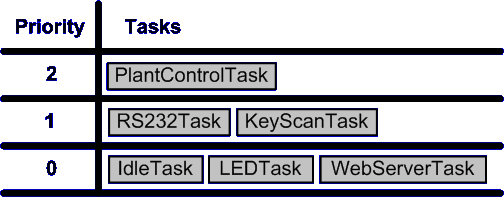|
||||||||||||||||
Solution #2
|
||||||||||||||||
 |
Simple, segmented, flexible, maintainable design with few interdependencies. |
 |
Processor utilisation is automatically switched from task to task on a most urgent need basis with no explicit action required within the application source code. |
 |
The event driven structure ensures that no CPU time is wasted polling for events that have not occurred. Processing is only performed when there is work needing to be done. |
 |
Power consumption can be reduced if the idle task places the processor into power save (sleep) mode, but may also be wasted as the tick interrupt will sometimes wake the processor unnecessarily. |
 |
The kernel functionality will use processing resources. The extent of this will depend on the chosen kernel tick frequency. |
 |
This solution requires a lot of tasks, each of which require their own stack, and many of which require a queue on which events can be received. This solution therefore uses a lot of RAM. |
 |
Frequent context switching between tasks of the same priority will waste processor cycles. |
Conclusion
This can be a good solution provided the RAM and processing capacity is available. The partitioning of the application into tasks and the priority assigned to each task requires careful consideration.
Example
This example is a partial implementation of the hypothetical application introduced previously. The FreeRTOS API is used.Plant Control Task
This task implements all the control functionality. It has critical timing requirements and is therefore given the highest priority within the system:
#define CYCLE_RATE_MS 10
#define MAX_COMMS_DELAY 2
void PlantControlTask( void *pvParameters )
{
TickType_t xLastWakeTime;
DataType Data1, Data2;
InitialiseTheQueue();
// A
xLastWakeTime = xTaskGetTickCount();
// B
for( ;; )
{
// C
vTaskDelayUntil( &xLastWakeTime, CYCLE_RATE_MS );
// Request data from the sensors.
TransmitRequest();
// D
if( xQueueReceive( xFieldBusQueue, &Data1, MAX_COMMS_DELAY ) )
{
// E
if( xQueueReceive( xFieldBusQueue, &Data2, MAX_COMMS_DELAY ) )
{
PerformControlAlgorithm();
TransmitResults();
}
}
}
// Will never get here!
}
Referring to the labels within the code fragment above:
- xLastWakeTime is initialised. This variable is used with the vTaskDelayUntil() API function to control the frequency at which the control function executes.
- This function executes as an autonomous task so must never exit.
- vTaskDelayUntil() tells the kernel that this task should start executing exactly 10ms after the time stored
in xLastWakeTime. Until this time is reached the control task will block. As this is the highest priority
task within the system it is guaranteed to start executing again at exactly the correct time. It will pre-empt
any lower priority task that happens to be running.
- There is a finite time between data being requested from the networked sensors and that data being received.
Data arriving on the field bus is placed in the xFieldBusQueue by an interrupt service routine, the control task
can therefore make a blocking call on the queue to wait for data to be available. As before, because it is
the highest priority task in the system it is guaranteed to continue executing immediately data is available.
- As 'D', waiting for data from the second sensor.
Embedded Web Server Task
The embedded web server task can be represented by the following pseudo code. This only utilises processor time when data is available but will take a variable and relatively long time to complete. It is therefore given a low priority to prevent it adversely effecting the timing of the plant control, RS232 or keypad scanning tasks.
void WebServerTask( void *pvParameters )
{
DataTypeA Data;
for( ;; )
{
// Block until data arrives. xEthernetQueue is filled by the
// Ethernet interrupt service routine.
if( xQueueReceive( xEthernetQueue, &Data, MAX_DELAY ) )
{
ProcessHTTPData( Data );
}
}
}
RS232 Interface
This is very similar in structure to the embedded web server task. It is given a medium priority to ensure it does not adversely effect the timing of the plant control task.
void RS232Task( void *pvParameters )
{
DataTypeB Data;
for( ;; )
{
// Block until data arrives. xRS232Queue is filled by the
// RS232 interrupt service routine.
if( xQueueReceive( xRS232Queue, &Data, MAX_DELAY ) )
{
ProcessSerialCharacters( Data );
}
}
}
Keypad Scanning Task
This is a simple cyclical task. It is given a medium priority as its timing requirements are similar to the RS232 task.The cycle time is set much faster than the specified limit. This is to account for the fact that it may not get processor time immediately upon request - and once executing may get pre-empted by the plant control task.
#define DELAY_PERIOD 4
void KeyScanTask( void *pvParmeters )
{
char Key;
TickType_t xLastWakeTime;
xLastWakeTime = xTaskGetTickCount();
for( ;; )
{
// Wait for the next cycle.
vTaskDelayUntil( &xLastWakeTime, DELAY_PERIOD );
// Scan the keyboard.
if( KeyPressed( &Key ) )
{
UpdateDisplay( Key );
}
}
}
If the overall system timing were such that this could be made the lowest priority task then the call to vTaskDelayUntil() could be removed altogether.
The key scan function would then execute continuously whenever all the higher priority tasks were blocked - effectively taking
the place of the idle task.
LED Task
This is the simplest of all the tasks.
#define DELAY_PERIOD 1000
void LEDTask( void *pvParmeters )
{
TickType_t xLastWakeTime;
xLastWakeTime = xTaskGetTickCount();
for( ;; )
{
// Wait for the next cycle.
vTaskDelayUntil( &xLastWakeTime, DELAY_PERIOD );
// Flash the appropriate LED.
if( SystemIsHealthy() )
{
FlashLED( GREEN );
}
else
{
FlashLED( RED );
}
}
}
NEXT >>> Solution #3: Reducing RAM utilisation
NXP tweet showing LPC5500 (ARMv8-M Cortex-M33) running FreeRTOS.
Meet Richard Barry and learn about running FreeRTOS on RISC-V at FOSDEM 2019
Version 10.1.1 of the FreeRTOS kernel is available for immediate download. MIT licensed.
View a recording of the "OTA Update Security and Reliability" webinar, presented by TI and AWS.
FreeRTOS and other embedded software careers at AWS.














